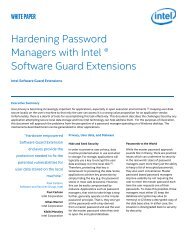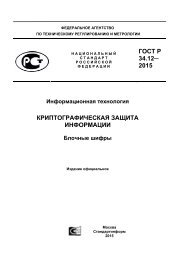ts_103127v010101p
ts_103127v010101p
ts_103127v010101p
Create successful ePaper yourself
Turn your PDF publications into a flip-book with our unique Google optimized e-Paper software.
4 General Aspec<strong>ts</strong><br />
7<br />
ETSI<br />
ETSI TS 103 127 V1.1.1 (2013-05)<br />
The present document defines two hardware-oriented scrambling algorithms and one software-oriented scrambling<br />
algorithm, as per the definitions in clause 3.2 that are suitable for IPTV content transported in an MPEG2-TS container.<br />
Conformance with the present document is achieved, if and only if, at least one of the said algorithms is implemented.<br />
To avoid any confusion, definitions of hardware-oriented and software-oriented scrambling algorithms shall be<br />
interpreted as follows:<br />
• A hardware-oriented scrambling algorithm is intended to be implemented in hardware only, wherein it should<br />
provide acceptable performance in order to support all common use cases. It is expected, however, that any<br />
implementation in software - such as general purpose CPUs - is uncomfortably slow.<br />
• A software-oriented algorithm is intended to be implemented primarily in software, with the possibility of a<br />
hardware implementation. It should provide acceptable performance in order to support all common use cases,<br />
regardless of the technology, hardware or software. In particular, the restriction to software-only<br />
implementations, without assistance of any dedicated hardware, should not restrict the usability of the<br />
scrambling algorithm; the use of a dedicated hardware should not be mandatory, nor excluded, yet the primary<br />
use case is a pure software implementation.<br />
The aforementioned definition of hardware-oriented scrambling algorithm should be understood to mean<br />
"hardware-only", whereas software-oriented scrambling algorithm should be understood to mean "software and<br />
hardware".<br />
5 Hardware-oriented Scrambling Algorithms<br />
5.1 Introduction<br />
The present document identifies two algorithms for which the descrambling method is hardware-oriented.<br />
Clause 5 includes descrambling elemen<strong>ts</strong> protected by intellectual property righ<strong>ts</strong>, in order to enable the enforcement of<br />
licensing conditions. The licensing fees will cover no more than the administrative cos<strong>ts</strong>.<br />
Some par<strong>ts</strong> of the descrambling elemen<strong>ts</strong> included in clause 5 are kept confidential and the full scale details are not<br />
publicly available. Details are further given in clauses 5.2.3 and 5.3.3.<br />
Two algorithms have been selected as solutions for the DVB IPTV scrambling algorithm: DVB Common Scrambling<br />
Algorithm Version 3, which shall be used for all normal implementations of the DVB IPTV Scrambler, and DVB<br />
Common Scrambling Algorithm Version 1 which should only be used for the purpose of backwards compatibility and<br />
in support of legacy implementations.<br />
5.2 DVB Common Scrambling Algorithm version 3<br />
5.2.1 Introduction<br />
The DVB Common Scrambling Algorithm version 3 (CSA3) is a device, apparatus or mechanism (whether<br />
implemented as hardware or software) designed or specifically adapted, totally or partially, to render unintelligible a<br />
service compatible with Standards by the use of CSA3 Scrambling Technology and any modifications and<br />
improvemen<strong>ts</strong> thereof and which can be descrambled using a common descrambling system in the form approved by<br />
the Steering Board of the DVB Project for Standards.<br />
CSA3 is comprised of the DVB CSA3 Descrambling System and Scrambling Technology. The specification for each is<br />
distributed separately under arrangemen<strong>ts</strong> with the European Telecommunications Standards Institute (ETSI), which<br />
ac<strong>ts</strong> as custodian for the companies which have developed the DVB CSA3 algorithm.





